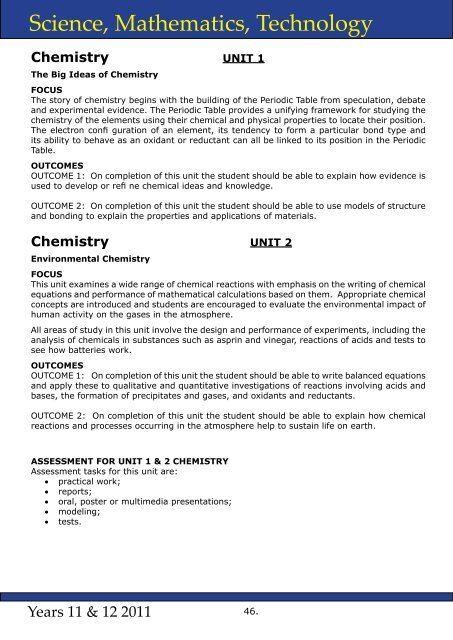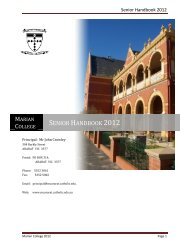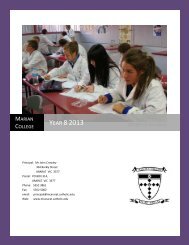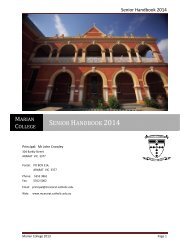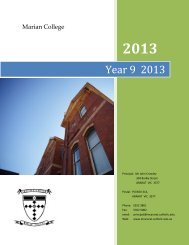Design and Technology - Marian College
Design and Technology - Marian College
Design and Technology - Marian College
You also want an ePaper? Increase the reach of your titles
YUMPU automatically turns print PDFs into web optimized ePapers that Google loves.
Science, Mathematics, <strong>Technology</strong><br />
Science, Mathematics, <strong>Technology</strong><br />
Chemistry UNIT 1<br />
The Big Ideas of Chemistry<br />
FOCUS<br />
The story of chemistry begins with the building of the Periodic Table from speculation, debate<br />
<strong>and</strong> experimental evidence. The Periodic Table provides a unifying framework for studying the<br />
chemistry of the elements using their chemical <strong>and</strong> physical properties to locate their position.<br />
The electron confi guration of an element, its tendency to form a particular bond type <strong>and</strong><br />
its ability to behave as an oxidant or reductant can all be linked to its position in the Periodic<br />
Table.<br />
OUTCOMES<br />
OUTCOME 1: On completion of this unit the student should be able to explain how evidence is<br />
used to develop or refi ne chemical ideas <strong>and</strong> knowledge.<br />
OUTCOME 2: On completion of this unit the student should be able to use models of structure<br />
<strong>and</strong> bonding to explain the properties <strong>and</strong> applications of materials.<br />
Chemistry UNIT 2<br />
Environmental Chemistry<br />
FOCUS<br />
This unit examines a wide range of chemical reactions with emphasis on the writing of chemical<br />
equations <strong>and</strong> performance of mathematical calculations based on them. Appropriate chemical<br />
concepts are introduced <strong>and</strong> students are encouraged to evaluate the environmental impact of<br />
human activity on the gases in the atmosphere.<br />
All areas of study in this unit involve the design <strong>and</strong> performance of experiments, including the<br />
analysis of chemicals in substances such as asprin <strong>and</strong> vinegar, reactions of acids <strong>and</strong> tests to<br />
see how batteries work.<br />
OUTCOMES<br />
OUTCOME 1: On completion of this unit the student should be able to write balanced equations<br />
<strong>and</strong> apply these to qualitative <strong>and</strong> quantitative investigations of reactions involving acids <strong>and</strong><br />
bases, the formation of precipitates <strong>and</strong> gases, <strong>and</strong> oxidants <strong>and</strong> reductants.<br />
OUTCOME 2: On completion of this unit the student should be able to explain how chemical<br />
reactions <strong>and</strong> processes occurring in the atmosphere help to sustain life on earth.<br />
ASSESSMENT FOR UNIT 1 & 2 CHEMISTRY<br />
Assessment tasks for this unit are:<br />
• practical work;<br />
• reports;<br />
• oral, poster or multimedia presentations;<br />
• modeling;<br />
• tests.<br />
Chemistry UNIT 3<br />
Chemical Pathways<br />
In this unit students investigate the scope of techniques available to the analytical chemist.<br />
Chemical analysis is vital in the work of the forensic scientist, the quality control chemist at a<br />
food manufacturing plant, the geologist in the fi eld, <strong>and</strong> the environmental chemist monitoring<br />
the health of a waterway. Each technique of analysis depends on a particular property or<br />
reaction of the chemical being investigated. Consequently, an underst<strong>and</strong>ing of the chemistry<br />
is necessary in learning how <strong>and</strong> why the techniques work. Some techniques of analysis have<br />
been refi ned over many years to make them quicker <strong>and</strong> more accurate. Other techniques are<br />
now used in combination to provide higher <strong>and</strong> more reliable levels of accuracy, for example<br />
gas chromatography <strong>and</strong> mass spectrometry. State of the art analytical tools such as the<br />
Australian synchrotron will enable investigation of the properties of materials <strong>and</strong> chemical<br />
reactions at the micro level.<br />
OUTCOMES<br />
OUTCOME 1: On completion of this unit the student should be able to evaluate the suitability<br />
of techniques <strong>and</strong> instruments used in chemical analyses.<br />
Outcome 2: On completion of this unit the student should be able to identify <strong>and</strong> explain the<br />
role of functional groups in organic reactions <strong>and</strong> construct reaction pathways using organic<br />
molecules.<br />
Chemistry UNIT 4<br />
Chemistry at Work<br />
In this unit students investigate the industrial production of chemicals <strong>and</strong> the energy changes<br />
associated with chemical reactions. Chemical reactions produce a diverse range of products<br />
we use <strong>and</strong> depend on every day. Access to large quantities of raw materials <strong>and</strong> reliable<br />
energy supplies for these reactions is necessary to maintain continuous production of high<br />
quality useful chemicals. Features that affect chemical reactions such as the rate <strong>and</strong> yield or<br />
equilibrium position are investigated. Students explore how an underst<strong>and</strong>ing of these features<br />
is used to obtain optimum conditions in the industrial production of a selected chemical.<br />
OUTCOMES<br />
OUTCOME 1: On completion of this unit the student should be able to analyse the factors that<br />
determine the optimum conditions used in the industrial production of the selected chemical.<br />
OUTCOME 2: On completion of this unit the student should be able to analyse chemical <strong>and</strong><br />
energy transformations occurring in chemical reactions.<br />
ASSESSMENT<br />
Both units include School Assessed Coursework that contributes 34% to the Study Score as<br />
well as a mid-year examination (Unit 3) <strong>and</strong> an end of year examination which each contribute<br />
33% to the Study Score.<br />
Years 11 & 12 2011 46. 47. Years 11 & 12 2011


